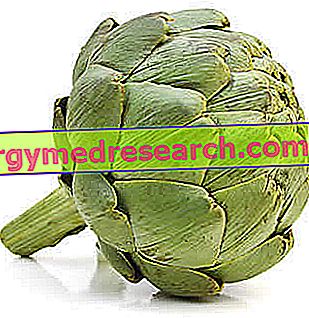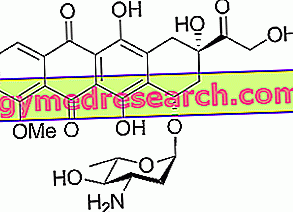Generality
Many expectant women wonder if the use of enamel during pregnancy can be considered safe.

The answer to this question may vary depending on the type of product used and on the reason for which the enamel is applied. In fact, if the enamel you want to apply is cosmetic, in general and following certain precautions, its use is permitted. The speech varies, however, when a medicated enamel has to be applied; in such situations, the doctor's opinion is absolutely essential.
Nail Polish for Cosmetic Use
Pregnant Nail Polish for Cosmetic Use
The enamel for cosmetic use is the nail polish that is normally applied in order to beautify or give color to the nails of the hands and feet, therefore it is applied purely for aesthetic purposes . There are many types on the market: colored, transparent, with or without glitter, with a glossy or matte finish and so on. However, regardless of the coloring, the finish and the final result that you would like to achieve, many future mothers ask themselves "enamel in pregnancy: yes or no?"
To tell the truth, opinions on the subject are conflicting and the safety of using enamel during pregnancy gives rise to many conflicting opinions. Despite this, in general, many believe that the product being discussed can also be used by mothers-to-be, provided certain precautions and precautions are adopted, such as:
- Use quality nail polishes and, above all, of known origin . Beware, therefore, of enamels with unknown and unlabeled names that can be found in cheap markets or shops.
- Use enamels without dangerous substances, such as toluene, formaldehyde and phthalates (in particular, dibutyl phthalate - DBT). Nowadays, the enamels containing these substances are definitely rare, however, it is always good to check the list of ingredients - INCI. If the ingredients are not specified, avoid buying the enamel.
- Once the right nail polish has been identified, make sure to apply it in a well-ventilated place avoiding inhaling the product's vapors ; in fact, even if toluene, phthalates or formaldehyde are not present, it is always good to avoid breathing the vapors of the substances used to make the enamel. In addition to this, the smell of the product may be too strong for the future mother causing nausea or even vomiting . In fact, during pregnancy, women tend to become more sensitive to different types of odors.
- Apply the nail polish as precisely as possible, avoiding "smearing" on the area of skin surrounding the nail, thus avoiding applying the nail polish to the skin .
- Avoid biting your nails in order not to ingest parts of enamel.
- To remove nail polish during pregnancy, use safe, quality nail polish removers free of hazardous substances . If in doubt, it is always good to read the list of product ingredients carefully.
- Similarly to what was said for the application of the enamel during pregnancy, even its removal must be carried out in well-ventilated areas, avoiding breathing solvent vapors.
In truth, the above precautions should be followed by all women, regardless of the state of pregnancy or not. However, if for non-pregnant women the aforementioned precautions can be adopted in a "more flexible" manner, pregnant women cannot afford to evade in any way.
In any case, the application of the enamel during pregnancy should not cause any harm to the fetus, since the substances contained in the product are generally not absorbed by the nails.
However, since the application of the enamel during pregnancy for aesthetic purposes is not indispensable, as a precautionary measure, the use of the product in question could be avoided until the end of the gestation period.
Please note
Since the question "enamel in pregnancy" is still rather debated and has given rise to numerous conflicting opinions, for the avoidance of doubt, pregnant women should seek the advice of their doctor or their own before using this product. gynecologist.
Negative Effects Caused by Incorrect Use of Pregnant Enamel
Although, in principle, enamel during pregnancy is not prohibited, improper and / or excessive use of the product, as well as the use of poor quality enamels can cause damage to the nails, such as:
- Nail fragility due to excessive use of enamel;
- Appearance of yellow spots on the nail plate (xantonichia);
- Onyxia lamellina ( flaking nails);
- Leukonychia (appearance of white spots on the nails).
Please note
The negative effects deriving from the incorrect use of these nail products can occur either with the application of enamel during pregnancy, or with the incorrect application of the product in non-pregnant women. Therefore, it is advisable to pay attention and follow the precautions due to all women and not just to those in expectation.
Nail Reconstruction, Gel Polish and Semi-permanent Nail Polish
According to many dermatologists, nail reconstruction using so-called gel polish, as well as the application of semi-permanent enamels should be avoided, not so much because the products used in this area can cause harm to the fetus, but because:
- The practice of nail reconstruction and the application of gel or semi-permanent nail polish (with or without reconstruction) require that the nail is first made rough by using a file and then covered with various layers of different types of enamel (base, color, top coat, etc.) that will dry when exposed to rays emitted by low-power UV lamps positioned inside special ovens. Furthermore, the filing phase is also required for the removal of the gel polish; for the semi-permanent, instead, a special solvent is used. However, all these procedures can further worsen the condition of the future mother's nails, which generally tend to be more fragile than normal due to the pregnancy itself.
- In addition to what has been said so far, in order to resort to treatments of this type on the nails, pregnant women should be sure that in the beauty center of reference all the hygiene rules of the case are followed with extreme rigor (use of disposable instruments and sterilization of those not disposable ) in order to avoid running into the contraction of infections of any kind (bacterial, viral or fungal). In such a case, in fact, fetal health could also be compromised.
Medicated Nail Polish
Pregnant Nail Polish for Medical Uses
The enamel in pregnancy used for medical purposes has nothing to do with the classic colored nail polish that is applied for aesthetic purposes. In fact, in the medical field the so-called medicated enamels are used. They are real drugs because they are formulated with active ingredients whose use is necessary to counteract certain nail diseases.
In detail, the active ingredients with which they are formulated have an antifungal (or antifungal, if you prefer) and, for this reason, their use is indicated in the treatment of nail fungus ( onychomycosis ).
Among the active ingredients most commonly used in these medicated enamels we find amorolfine (Locetar®, Onilaq®) and ciclopirox (Niogermox®).
Enamel during pregnancy for medical use (medicated enamels based on anti-fungal active ingredients) can only and exclusively occur in cases of real need, only if prescribed by the doctor and only under the strict supervision of the latter.
Many medicated enamels used to counter onychomycosis are freely available without the need to present the medical prescription, despite this, pregnant women, as well as breastfeeding mothers, must not resort to the use of similar products except on express advice of the doctor.
Side effects
Clearly, since they are medicinal products in all respects, even medicated enamels can cause side effects, such as the appearance of nail fragility and nail discoloration .
In addition to this, the application of enamel during pregnancy for medical use can cause allergic reactions in sensitive individuals that can manifest themselves with the appearance of hives, itching, redness and burning skin.



